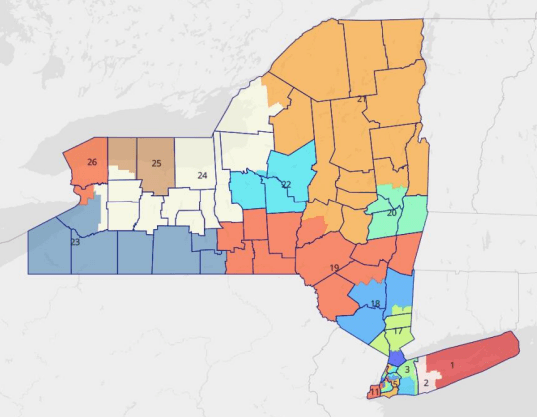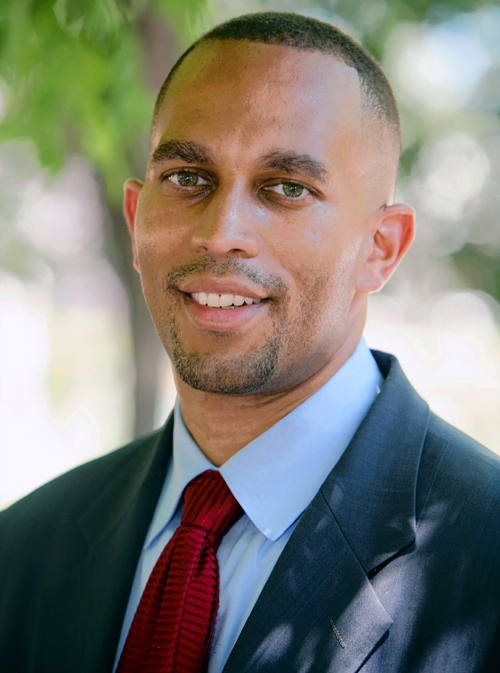The newly proposed Congressional maps drawn up by the court-appointed “special master” would significantly shake up the races for House of Representatives in Brooklyn this year, forcing a number of longtime reps to either run in districts they don’t live in or contest a race against a fellow incumbent, and creating other new, wide-open districts to be snagged by a new generation.
The special master, Jonathan Cervas, submitted his map proposal to the Steuben County Supreme Court on Monday, May 16. He was selected last month to draw up neutral maps for the state’s Congressional and State Senate districts after maps drawn up by Albany Democrats were struck down as unconstitutional partisan gerrymanders.
The new maps are not final, but in the likely event new maps look more like Cervas’ than Albany Democrats’, the upcoming elections in Brooklyn will be thrown in disarray as gerrymandered districts drawn to benefit incumbents are tossed aside.
“This map probably makes more changes to the congressional map than any other plan in 40 years,” said Jeff Wice, the director of the Census and Redistricting Institute at New York Law School, in an interview.
Brooklyn Democrats Hakeem Jeffries and Yvette Clarke, for instance, will now both live within the confines of Clarke’s 9th District; Jeffries’ 8th still includes the southeastern coastal Brooklyn nabes he’s long represented, but it no longer snakes through Bed-Stuy to his home neighborhood of Prospect Heights.
In a statement, Jeffries excoriated the new maps, arguing they target Black representation on Capitol Hill, even comparing them to Jim Crow, and should be ruled unconstitutional.
“The draft redistricting map viciously targets historic Black representation in NY, and places 4 Black members of Congress into the same district,” Jeffries said on Twitter. “This tactic would make Jim Crow blush. The draft map is unacceptable, unconscionable & unconstitutional.”
In a longer prepared statement, Jeffries deemed McAllister a “judicial overseer” and Cervas an “unelected, out-of-town Special Master,” and said both had taken a “sledgehammer” to decades of efforts by Black Brooklyn communities to gain representation in Congress, starting with Shirley Chisholm. He took particular exception to Cervas’ splitting of Bedford-Stuyvesant between two districts.
“Apparently, the Steuben County Court either doesn’t know this history or doesn’t care, notwithstanding voluminous public testimony,” Jeffries said. “The right-wing Court in Steuben County has released a map that is unacceptable, unconscionable and unconstitutional. The Court of Appeals needlessly stripped away the ability of the elected representatives of the New York State legislature to cure any defect it claimed existed. Instead, a flawed process was put into place which has now led to a flawed result. Shame on everyone involved who have brought us to this point.”
What’s more, two of New York’s longest-serving members of Congress will be forced to face one another in a primary: Carolyn Maloney’s 12th District has been redrawn to include just Manhattan, essentially the whole swath between 14th Street and the top of Central Park. That will pit her against Jerry Nadler, the dean of the state’s Congressional delegation, who has long maintained a base of support on the Upper West Side, but whose 10th District now includes Lower Manhattan and a large swath of Brooklyn, including brownstone Brooklyn, Park Slope, Kensington, and Borough Park.
Nadler’s district had long been one of the most conspicuously gerrymandered in the whole country, drawn explicitly to connect Jewish communities on the Upper West Side and Borough Park under one representative. In a statement Monday, Nadler said he plans to run in the proposed 12th District.
“I believe these newly proposed lines by the Special Master violate the NYS constitutional requirements of keeping communities of interest together and keeping the cores of existing districts largely intact,” Nadler said on Twitter. “However, provided that they become permanent, I very much look forward to running in and representing the people of the newly created 12th District of New York.”
Maloney also confirmed Monday that she would run in the 12th District, setting up a high-stakes matchup between two of New York’s highest-profile legislators.
That leaves the 10th District race wide open for candidates from Lower Manhattan and Brooklyn. State Sen. Brad Hoylman, who represents the west side of Manhattan in Albany and lives in the West Village, said Monday that he is “very seriously considering” a run in the new 10th District. Others will likely announce candidacies in short order.
Members of Congress are not required to live in their districts, only in the state they’re elected in, per the requirements to serve outlined in the US Constitution. But Wice said he imagines the affected incumbents would either run in their new districts, or move into the new lines of their old district after this year’s elections.
“Not living in your district makes for bad optics,” he said. “Generally a member of Congress would want to live in the district they represent and often members have moved after elections based on new lines in the past.”
In the city’s only competitive general election district, the 11th, the map is surprisingly intact from that proposed by Albany Democrats earlier this year. In addition to the entirety of Staten Island, the district still includes Bay Ridge and Sunset Park, though now the district includes wider swaths of those neighborhoods plus a bit of Red Hook instead of Park Slope, which was included under Democrats’ plan.
Nicole Malliotakis, the district’s rep and the city’s only congressional Republican, had previously accused Democrats of intentionally redrawing her district to make her reelection more difficult: the original plan would turn the district into one where Joe Biden voters outnumber Donald Trump voters by nine percentage points, according to the CUNY Graduate Center’s Redistricting and You application. Cervas’ map instead preserves a slight advantage for Trump voters in the new district, but Wice believes the district will still be competitive owing to the strength of progressive candidates in the Brooklyn section in past elections.
“[Malliotakis] is gonna have her hands full with a tough race because the district also includes Sunset Park, South Slope, and Red Hook,” Wice said. “Those are the same neighborhoods that helped Marcela Mitaynes defeat Felix Ortiz two years ago. You have a very strong progressive base in Sunset Park that’s growing stronger, that may offset the Republican advantages elsewhere in the district.”
Brittany Ramos DeBarros, one of the Democrats vying to face Malliotakis this summer, largely concurred.
“Brittany is the only person running to have not lost to Nicole Malliotakis and, as a working-class Afro-Latina combat veteran running on a popular agenda; she is, without question, the best candidate to defeat her this November,” a campaign spokesperson said. “With the new draft of the majority-minority maps and an organized grassroots coalition of supporters and elected officials that have recently won big in these areas, she’s poised to win in August against Max Rose and deliver a historic victory for the people.”
A spokesperson for the Malliotakis campaign declined to comment since the maps haven’t been finalized by a judge. Her other Democratic challenger, former Rep. Max rose, did not respond to a request for comment.
In his submission to Steuben County Judge Patrick McAllister, who is overseeing the redistricting case, Cervas noted that his map’s districts are significantly more “compact” than those drawn by Democrats, who took over the process after a bipartisan redistricting commission failed to reach a compromise map. He also noted that it features eight competitive races throughout the state, as opposed to three in the Democrats’ plan. Under Cervas’ plan, Brooklyn will only be repped by five members of Congress rather than six.
Democrats nationally had hoped that a favorable map in New York could help offset widely expected losses in November, especially in states where Republican-led gerrymanders have been allowed to go through like Florida and Ohio.
New Yorkers have until Wednesday to submit public comment on the map proposal, before the Friday, May 20 due date. The final maps are likely to be substantially similar to Cervas’, Wice expects.
Cervas also submitted his proposed State Senate maps on Monday afternoon, and while they could, like the Congressional maps, prove beneficial to New York Republicans, in Brooklyn the changes aren’t as drastic as the ones for Congress.
Most Brooklyn Senate districts under Cervas’ plan remain largely the same as those proposed by Albany Democrats, with a few notable exceptions. Arguably the biggest change is Senate District 26, which will now encompass the western Brooklyn waterfront from Bay Ridge all the way up to Brownstone Brooklyn, possibly entrenching a longtime swing seat in the hands of Democrat Andrew Gounardes, who currently represents a swath of southern Brooklyn nabes.
The 23rd District, repped by Diane Savino and which was redrawn to include parts of brownstone Brooklyn, has once again been redrawn back to largely its original configuration of the Coney Island peninsula and the north shore of Staten Island.
The new plurality Asian district in southwestern Brooklyn is largely intact, with Asians still the largest demographic group in its boundaries, though it’s now known as District 17 instead of 27.
Williamsburg and Greenpoint, meanwhile, are getting lumped into a new 59th District, which also includes Long Island City, Astoria, and the east side of Manhattan between 14th Street and the United Nations headquarters.

























